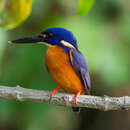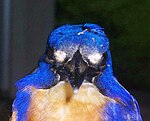zh-TW
在導航的名稱


Der Azurfischer oder Azurzwergfischer (Ceyx azureus, Syn.: Alcedo azurea) ist eine australische Eisvogelart. Es werden in dem großen Verbreitungsgebiet der Art mehrere Unterarten unterschieden. Er ist zwar größer als der Mangrovenzwergfischer, der zur selben Gattung gehört. Mit einer Körperlänge von 13 bis 14 Zentimeter bei einigen der Unterarten zählt er aber immer noch zu den kleinsten Eisvögeln.[1]
Die Bestandssituation des Azurfischer wurde 2016 in der Roten Liste gefährdeter Arten der IUCN als „Least Concern (LC)“ = „nicht gefährdet“ eingestuft.[2]
Beim 18 cm langen und 35 g schweren Azurfischer ist die Oberseite azurblau und an der Unterseite rot-orange gefärbt. Er hat weiße Flecken hinter den Ohren und an der Kehle, sowie orange vor den Augen. Der lange dünne Schnabel ist schwarz mit einer hellen Spitze.
Die Füße sind rot gefärbt.
Das Verbreitungsgebiet des Azurfischers umfasst das nördliche, das östliche und südöstliche Australien, Tasmanien, die Molukken, die kleinen Sunda-Inseln und Neuguinea. Der Vogel lebt an Flüssen, Billabongs, Seen und Sümpfen mit schattiger überhängender Vegetation. In weiten Teilen seines Verbreitungsgebietes ist er ein Standvogel, der ganzjährig ein Revier besetzt.[3]
Im Norden Australiens kommt die Unterart Alcedo azurens ruficollaris vor. Sie ist vergleichsweise häufig Das Verbreitungsgebiet reicht dort von Kimberley bis nach Cape York im Südosten Australiens. Er unterscheidet sich von den anderen Unterarten durch eine bronzefarbene Brust, die links und rechts von lila Gefieder eingefasst ist. Er lebt überwiegend entlang von breiten Fließgewässern in Monsunwäldern in Küstennähe, kommt aber auch an permanenten Wasserstellen weiter im australischen Landesinneren vor.[1] Die Größe des Reviers ist auch von der Breite des jeweiligen Fließgewässers beeinflusst. An Stellen, die dem Azurfischer ideale Lebensbedingungen bieten, benötigt ein Paar einen Flussabschnitt von 200 bis 500 Meter Länge.
Grundsätzlich ist der Azurfischer im Süden und in den gemäßigteren Teilen des australischen Kontinents seltener. In Teilen seines historischen Verbreitungsgebietes ist er sogar ausgestorben.[1] In Ostaustralien kommt die Nominatform vor, die entlang kleiner Fließgewässer nahe der Küste lebt. Er ist aber auch entlang des Murray Rivers und des Murrumbidgee Rivers zu finden.[1] An geeigneten Stellen findet sich hier pro ein Kilometer Flusslauf ein Paar.[4]
Bestandsveränderungen sind in der Regel eine Folge von Veränderungen der Wasserqualität und der Fließgeschwindigkeit. In Teilen seines Verbreitungsgebietes hat sich die Anlage von Staudämmen und Wehren negativ auf die Populationsdichte ausgewirkt. Er hat insbesondere dann Mühe ausreichend Nahrung zu finden, wenn Eingriffe in die Fließgewässer dazu führen, dass die Flüsse mehr Erde und Lehm mit sich führen. Der Azurfischer hat allerdings auch von der Einführung des Karpfen durch europäische Siedler profitiert, der mittlerweile zu einem seiner häufigeren Beutefischarten zählt.[4]
Von einer Sitzwarte aus oder aus dem Rüttelflug taucht der Azurfischer ins Wasser, um Fische und Krebse zu fangen. Die Beute wird getötet, indem sie gegen einen Ast geschlagen wird, und dann mit dem Kopf voran geschluckt. Wasserinsekten werden im Flug gefangen. Manchmal ergänzen Frösche die Nahrung.
Der Azurfischer lebt monogam und verteidigt sein Brutrevier. Die 80–120 cm lange Bruthöhle wird in eine Sandbank gegraben. Zu tief gelegene Bruthöhlen können bei Hochwasser zerstört werden. Beide Elternvögeln bebrüten die vier bis sieben Eier 21 Tage lang und füttern danach die Küken. Die Nestlingszeit dauert 28 Tage.
Der Azurfischer oder Azurzwergfischer (Ceyx azureus, Syn.: Alcedo azurea) ist eine australische Eisvogelart. Es werden in dem großen Verbreitungsgebiet der Art mehrere Unterarten unterschieden. Er ist zwar größer als der Mangrovenzwergfischer, der zur selben Gattung gehört. Mit einer Körperlänge von 13 bis 14 Zentimeter bei einigen der Unterarten zählt er aber immer noch zu den kleinsten Eisvögeln.
Die Bestandssituation des Azurfischer wurde 2016 in der Roten Liste gefährdeter Arten der IUCN als „Least Concern (LC)“ = „nicht gefährdet“ eingestuft.
The azure kingfisher (Ceyx azureus) is a small kingfisher in the river kingfisher subfamily, Alcedininae.[2]
The azure kingfisher measures 17–19 cm (6.7–7.5 in) in length,[2] and the male weighs 29–32 g (1.0–1.1 oz) while the female is slightly heavier at 31–35 g (1.1–1.2 oz).[3] It is a very colourful bird, with deep blue to azure back, a large white to buff spot on the side of the neck and throat, rufous-buff with some blue-violet streaks on the breast and flanks.[4] The feet are red with only two forward toes.[4] The lores (the region between the eye and the bill) are white and inconspicuous except in front view, where they stand out as two large white eye-like spots which may have a role in warding off potential predators.

The subspecies (see box at right) differ only in minor details: compared with the nominate subspecies Ceyx azureus azureus, C. a. ruficollaris is smaller, brighter, and has more blue on the flanks; C. a. diemenensis is rather large, short-billed, and has a distinctly darker crown; C. a. lessoni is more contrasting, with little blue on the flanks; C.a. affinis has a red billtip, as has the smaller C.a. yamdenae; and C. a. ochrogaster is very pale below. Still, there is very little intergradation in the areas where subspecies meet. Comparing subspecific variation with climate data, the former's pattern does not follow and in some instances runs contrary to Bergmann's Rule and Gloger's Rule.[5][3]
The generic name Ceyx (/ˈsiːɪks/) derives from Ancient Greek: Κήϋξ, romanized: Kēüx, a mythological seabird that was drowned at sea and then found washed ashore by his wife Alcyone, after which both were metamorphosed into kingfishers.[6] The specific epithet is Mediaeval Latin azureus, 'azure'.[6]
The azure kingfisher is found in northern and eastern Australia and Tasmania, as well as the lowlands of New Guinea and neighbouring islands, and out to North Maluku and Romang. The contact zone between the mainland Australian subspecies is along the east coast of Far North Queensland, between Cairns and Princess Charlotte Bay,[5] and that of the New Guinea ones between Simbu Province and the northern Huon Peninsula, as well as south of Cenderawasih Bay.[3]
The habitat of the azure kingfisher includes the banks of vegetated creeks, lakes, swamps, tidal estuaries, and mangroves.[2][4]
It is common in the north of its range, tending to uncommon in the south.[4] It is generally sedentary, although some seasonal migration may occur.[4]
The azure kingfisher feeds on small fish, crustaceans (such as shrimps, amphipods and freshwater yabbies), water beetles, spiders, locusts, and small frogs or tadpoles.[3] It is often difficult to see until it quickly darts from a perch above water.
The breeding season of the azure kingfisher is from September to April in northern Australia and from August to February in southern Australia, sometimes with two broods.[3] The nest is in a chamber at the end of a 1 m (3 ft 3 in) long burrow in an earthen creek bank.[2] A clutch of 4–6 white, rounded, glossy eggs, measuring 22 mm × 19 mm (0.87 in × 0.75 in), is laid.[4] Both parents incubate the eggs for 20–22 days, and then feed the hatchlings for a further 3 to 5 weeks.[4][3] The nests are occasionally destroyed by floods and their contents may be taken by the brown snake.[3]
The azure kingfisher is usually silent, but makes a sharp, squeaky call when breeding.[4] Its voice is a high-pitched, shrill "pseet-pseet", often in flight.[3][2]
Although the population of azure kingfishers is decreasing, their wide distribution enables classification as a species of least concern on the IUCN Red List.[1]
The azure kingfisher (Ceyx azureus) is a small kingfisher in the river kingfisher subfamily, Alcedininae.
El martín pescador azur (Alcedo azurea)[2] es una especie de ave coraciforme de la familia Alcedinidae que vive en Australasia.
Mide entre 17-19 cm de largo. La subespecie nominal tiene sus partes superiores de color azul intenso y sus partes inferiores son de tonos canela anaranjados, con vetas azul violáceo en los flancos. Tiene la garganta blanca y una lista blanca desde la altura de los oídos hasta la nuca. Su lorum también es blanco, aunque solo es visible de frente. Su pico es negro y sus patas rojas.
La subespecie se diferencian en pequeños detalles:
Se extiende en las Molucas septentrionales, las islas Tanimbar, Romang, Nueva Guinea e islas circundantes, el norte y este de Australia y Tasmania.
Entre sus hábitats naturales se encuentran los arroyos, lagos, pantanos, estuarios de marea y manglares.
El martín pescador azur pesca al acecho inmóvil desde un posadero, por lo que suele ser difícil verlo hasta que se lanza al agua. Se alimenta de cangrejos de río y peces pequeños.
Anida en túneles de hasta un metro escavados en taludes arenosos junto a arroyos. Pone entre 5 y 7 huevos redondeados blancos y brillantes.
El martín pescador azur (Alcedo azurea) es una especie de ave coraciforme de la familia Alcedinidae que vive en Australasia.
Ceyx azureus
Le Martin-pêcheur à dos bleu (Ceyx azureus), dit aussi Martin-pêcheur azuré, est une espèce d'oiseaux de la famille des Alcedinidae, vivant en Australie, en Papouasie-Nouvelle-Guinée, dans les Moluques du Nord et en Indonésie.
C'est un oiseau très coloré, avec un dos variant du bleu profond à l'azur, avec une grande tache blanche sur le côté du cou et sur la gorge. Le plumage de sa poitrine est roux avec quelques stries bleu-violettes sur les flancs. Les pattes sont rouges avec seulement deux orteils à l'avant.
Les sous-espèces diffèrent seulement dans de petits détails : par exemple, A. a. ruficollaris est plus petit, plus "lumineux", et a plus de bleu sur les flancs. A. a. diemenensis est plutôt grand, et a le sommet de la tête nettement plus foncé. A. a. lessoni est plus contrasté, avec peu de bleu sur les flancs.
D'après la classification de référence (version 5.2, 2015) du Congrès ornithologique international, cette espèce est constituée des six sous-espèces suivantes :
Ceyx azureus
Le Martin-pêcheur à dos bleu (Ceyx azureus), dit aussi Martin-pêcheur azuré, est une espèce d'oiseaux de la famille des Alcedinidae, vivant en Australie, en Papouasie-Nouvelle-Guinée, dans les Moluques du Nord et en Indonésie.
Il martin pescatore azzurro (Ceyx azureus Latham, 1801) è un uccello appartenente alla famiglia Alcedinidae.[2]
Si trova nell'Australia settentrionale e orientale e in Tasmania, nonché nelle pianure della Nuova Guinea e nelle isole vicine, nel nord di Maluku e Romang.
Il martin pescatore azzurro (Ceyx azureus Latham, 1801) è un uccello appartenente alla famiglia Alcedinidae.
Si trova nell'Australia settentrionale e orientale e in Tasmania, nonché nelle pianure della Nuova Guinea e nelle isole vicine, nel nord di Maluku e Romang.